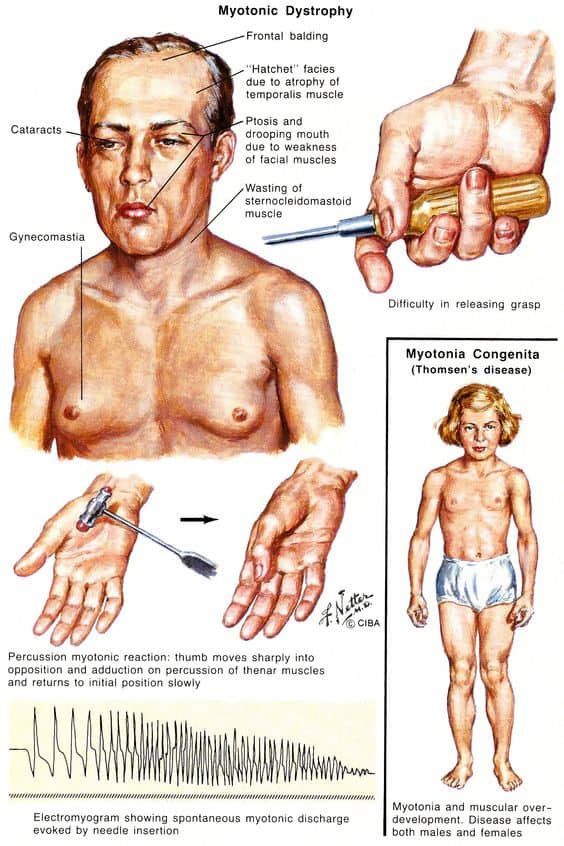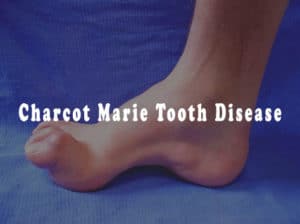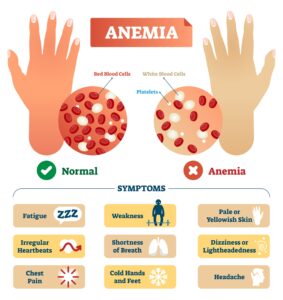Myotonic dystrophy
Myotonic dystrophy, also called myotonia atrophica, is the most common form of muscular dystrophy. It is an inherited disorder and affects the skeletal, smooth, and cardiac muscles of the body. Characteristic features of the disease include progressive muscle degeneration, muscle shrinkage, and weakness.
Inheritance
Myotonic dystrophy is an autosomal dominant trinucleotide repeat disorder. It means if a parent has this disease then 50% of the offsprings will also inherit it. The prevalence of myotonic dystrophy is 12 in 100000.
Classification of myotonic dystrophy
This disease can be further classified into two types:
- Myotonic dystrophy type 1 – caused by mutations dystrophia myotonica protein kinase (DMPK) gene in chromosome 19.
- Myotonic dystrophy type 2 – caused by mutations in ZNF9 gene in chromosome 3.
Myotonic dystrophy type 1
Myotonic dystrophy type I (Steinert disease) appears to be more common than type II. It usually involves peripheral muscles. This includes the muscles of the face, neck, hands, and feet. There are two variants of type I myotonic dystrophy:
- Mild myotonic dystrophy is apparent in mid to late adulthood. Patients have minimal myotonia and cataracts.
- Congenital myotonic dystrophy appears in newborns of mothers who have MD. It manifests symptoms at birth. Characteristic features include clubfoot, retarded growth, difficulty in breathing, weak muscle tone, and mental retardation.
Myotonic dystrophy type 2
Myotonic dystrophy type 2 is generally milder than type 1. It rarely occurs in childhood, and there is no congenital form of MD type 2. It involves the group of muscles closer to the center of the body called the proximal muscles. These are the muscles of the shoulders, elbows, and buttocks.
Which genes are responsible?
Both types of myotonic dystrophy are inherited in an autosomal dominant pattern. This means one defective allele is sufficient to cause the disease.
Myotonic dystrophy type 1 is a trinucleotide repeat disorder. The cause of DM type 1 is a mutation in the DMPK gene located on the long arm of chromosome 19. There is an extension of CTG, cytosine-thymine-guanine triplet repeat in the DMPK gene. These trinucleotide repeat expansions can occur due to an error in double-strand break repair or any DNA repair. The protein product of the DMPK gene, myotonic dystrophy protein kinase, plays a role in cell-to-cell communication. It is essential for the proper functioning of the cells in the brain, heart, and skeletal muscles.
On the other hand, a mutation in the ZNF9 gene located on chromosome 3 is a cause of myotonic dystrophy type II. The defect is a repeat in CCTG, cytosine-cytosine-thymine-guanosine tetranucleotide in the ZNF9 gene. As it involves the repetition of four nucleotides, it is called a tetranucleotide repeat disorder. The protein product of the ZNF9 gene is present in the cells of the heart and skeletal muscles, where it regulates the function of other genes.
In both DM type I and type II, the repeat expansion is transcribed into RNA and remains untranslated into protein.
Myotonic dystrophy symptoms
The features of myotonic dystrophy are likely to develop in the twenties or thirties. However, they can occur at any age. Patients with muscular dystrophy have trouble relaxing their muscles and have prolonged muscular contractions. In addition to this, patients experience problems in various functions which are given below –
Due to skeletal muscle involvement
- Slow relaxing of muscles. A typical finding is a slow relaxing grip after the handshake. This is a characteristic finding of myotonic dystrophy and can lead to clinical diagnosis.
- Limb muscle atrophy (shrinkage) and weakness.
- Atrophy of temporalis and masseter muscle. Temporary locking of the jaw.
- Difficulty in breathing (due to weakness of the muscles involved in breathing).
Due to cardiac muscle involvement
- Cardiac conduction defects (abnormalities in conduction of electrical signals through the heart). An ECG may show a prolonged PR interval.
- Heart failure due to cardiomyopathy.
- Arrhythmia
Due to smooth muscle involvement
- Slurred speech and problems with swallowing due to weakness of bulbar muscles and muscles of the esophagus.
- Digestive problem due to slowing of peristalsis.
Due to endocrine involvement
- Diabetes mellitus
- Hypothyroidism
- Infertility
Other features
- Frontal balding
- Haggard appearance
- Clouding of the lens of the eye (cataracts).
- Mental retardation


Difference between types of myotonic dystrophy
Myotonic dystrophy type 1 | Myotonic dystrophy type 2 |
Mutation in DMPK gene with an expansion of CTG sequence on gene causes MD type 1 | Mutation in the ZNF9 gene with an expansion of CCTG sequence on gene causes MD type 2. |
It affects the distal muscles of the body, such as the muscles of the face, neck, hands, and feet. | It affects proximal muscles of the body, such as the muscles of the shoulders, elbows, and hips. |
The congenital form of the disease occurs in newborns of mothers suffering from MD. Intellectual disability, retarded growth, clubfoot, and difficulty in breathing are characteristic features. | There is no congenital form of the disease. |
Shortened life expectancy in patients and death usually occur due to cardiac or respiratory failures. | Patients may have a normal lifespan. |
Treatment
There is no cure for myotonic dystrophy at present. Therefore, genetic counseling and support groups play a vital role in the management of this condition. The focus of treatment involves the management of symptoms, especially in patients with cardiopulmonary defects. A multidisciplinary team involving cardiologists, endocrinologists, neurologists, physiotherapists, occupational and social health workers are needed to manage this medical condition. Cardiac involvement requires lifetime cardiac monitoring and possibly insertion of a pacemaker to manage cardiac arrhythmias.
Medications
- Some studies reveal that clomipramine and imipramine can be beneficial in the treatment of myotonic dystrophy. However, we do not use these medications in patients with cardiac arrhythmias.
- Modafinil which is a central nervous system stimulant can also be implied in the treatment of MD.
- Musculoskeletal pain can be treated with pain-relieving medications.
- Testosterone replacement therapy can be implied with men with fertility issues.
Physical activity
The combination of strength and aerobic exercises has proved to increase muscle strength in patients with myotonic dystrophy. A stationary bicycle with an attached ergometer is effective and safe for patients of DM type I.
Mobility aids
Braces, canes, walkers, and scooters can work as mobility aids and help when muscle weakness progresses.
Prognosis
The prognosis of myotonic dystrophy depends on the type and severity of this disease. It is a progressive disease which means that the symptoms of the disease worsen with age.
Myotonic dystrophy type 2 has a better prognosis than type 1. There is a reduced life span in patients with MD type 1. The most common cause of death in patients of MD type 1 is cardiac or respiratory failure. Patients with mild symptoms of MD type I may have an improved life expectancy and normal lifespan.
Whereas the prognosis of MD type 2 is better, and patients may have a normal lifespan. However, there is an impairment of mobility at an early age. The ability to walk is completely retained by the age of 60.
Liked this article? Please write your thoughts in the comment section.
Click here to read other articles form us.


